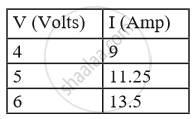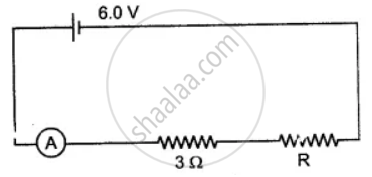Advertisements
Advertisements
प्रश्न
What is Ohm's law? Explain how it is used to define the unit of resistance.
उत्तर
According to Ohm's law, the current (I) flowing through a wire is directly proportional to the potential difference (V) across it, provided its temperature remains the same.
Thus I α V.
V / I = Constant = R
V = IR
Here R is the resistance.
The unit of resistance is ohm (Ω).
One ohm (Ω) is the resistance of a conductor when a potential difference of one volt is applied to its ends and a current of one ampere flows through it.
APPEARS IN
संबंधित प्रश्न
How much energy is given to each coulomb of charge passing through a 6 V battery?
State two causes of energy loss in a transformer.
What do you understand by the term "electric potential"? (or potential) at a point? What is the unit of electric potential?
Explain the statement ‘the potential difference between two points is 1 volt’.
The following table shows current in Amperes and potential difference in Volts.
What will be the nature of the graph between the current and potential difference? (Do not draw a graph.)

Electric cells having 2V potential difference each have been connected in the form of a battery. What will be the total potential difference of the battery in both cases?
The figure shows a circuit. When the circuit is switched on, the ammeter reads 0.5 A.

(i) Calculate the value of the unknown resistor R.
(ii) Calculate the charge passing through the 3 Ω resistor in 120 s.
(iii) Calculate the power dissipated in the 3 Ω resistor.
Two bulbs are marked 100 W, 220 V and 60 W, 110 V. Calculate the ratio of their resistances.
Define electric potential and potential difference.
If P and V are the power and potential of device, the power consumed with a supply potential V1 is:


